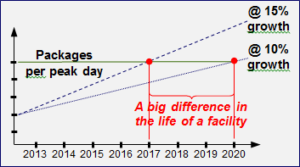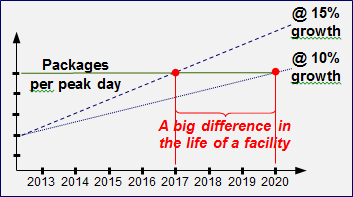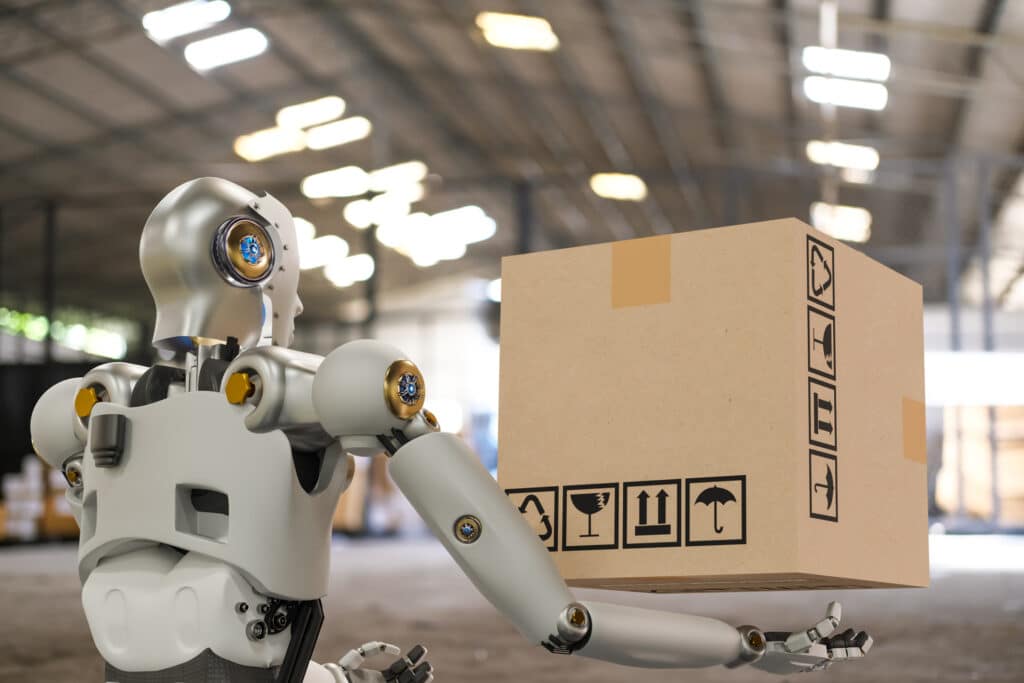At the beginning of a project, we invariably are given a planning guideline that goes something like this. “We want to plan for a system that will carry us through our peak in 2018.” It has always been a surprise to me that this important goal seems to be set based on hazy definitions of business growth and a feeling that we need to look out into the future – but not too far.
When I started my career at Oldsmobile, the marketing folks always provided us with forecasts that inevitably had aggressive beginnings, and weak endings.

Packages per peak day
Of course, aggressive growth, compounded forever becomes extreme very quickly. So, tapering them off in future years was the only way to make them look reasonable.
Later in life, we used sensitivity analysis to help people see the projected difference between various growth rates.
But, having a rational way to discuss the future still leaves many capacity questions unanswered.
Three dimensions of capacity
Warehouse capacity requirements fall into three distinct categories; inventory holding, throughput and SKU count. Growth rate is not usually the same for all of these. We are often fooled by optimism regarding improved control of inventory and SKU growth. But, marketplace realities often foil the plans. It’s best to look at our real track record over the past 3-5 years and accept it as fact.
Can we easily add capacity?
Ideally, capacity would be infinitely variable, and added just as we need it. Up to a point, for manual processes, throughput capacity can be linear with growth by gradually adding staff, until we reach a point of congestion. For more mechanized processes, there may be a possibility of adding capacity in phases, working toward a long-range master plan – but usually the increments are bigger, more costly, and more painful when you miss either low or high.
Storage of inventory, on the other hand, will require more space, assuming that we have already done the best we can with storage density and slot utilization. Pre-planning building expansion by defining an expansion wall and properly arranging functions inside will minimize rearrangement when the time comes. Doing some grade preparation outside during initial construction makes the addition of space much faster and easier. And it often makes sense to have a plan for using external overflow if your inventory exceeds capacity for only for a small time each year.
Adding pick faces for a growing product offering usually means stealing space from storage. Alternatively, slow moving product may be compressed into a higher density, but perhaps less efficient storage mode to make room for the fast movers.
For each operation, there are logical capacity increments. It’s also good practice to plan the transition from simple picking processes to more complex batch processes as the volume projections grow.
How should we handle peaks?
Sometimes, peak requirements are extreme; as in back-to-school, special promotion and Christmas related businesses. Because these peaks are often at the heart of our business, we cannot fail to meet them. But, installing for an extreme peak 5-10 years away leaves us with a system that is significantly underutilized 90% of the time.
Close analysis of the way business changes at peak may provide an opportunity to create a temporary parallel process, e.g. we may duplicate the pick face for the fastest movers.
As of September 8, 2020, Crimson & Co (formerly The Progress Group/TPG) has rebranded as Argon & Co following the successful merger with Argon Consulting in April 2018.







